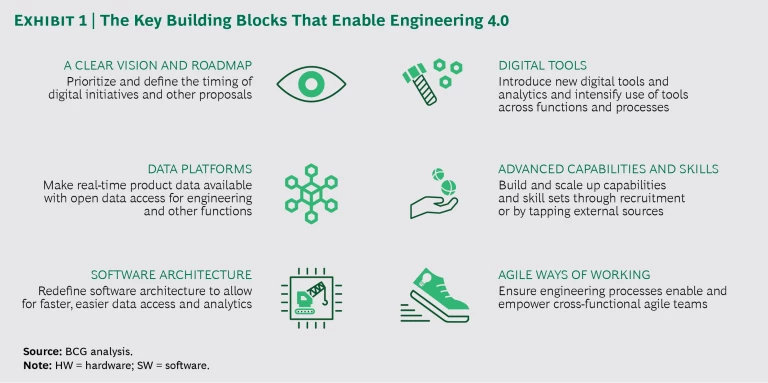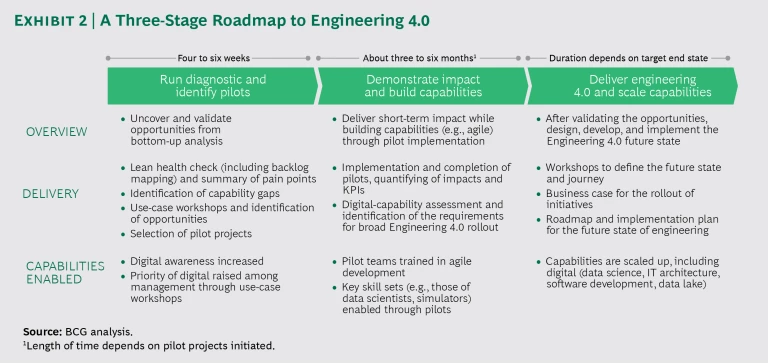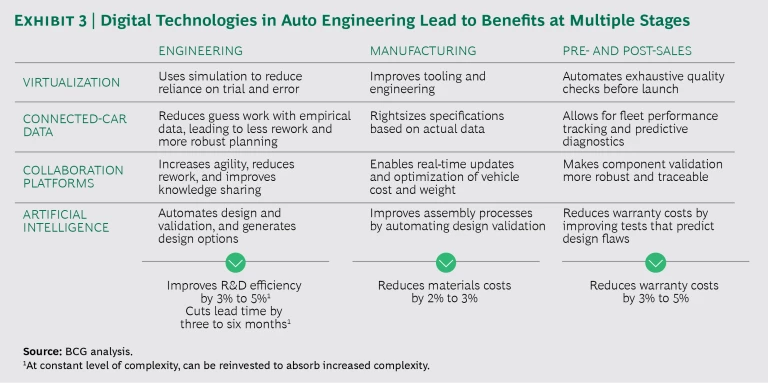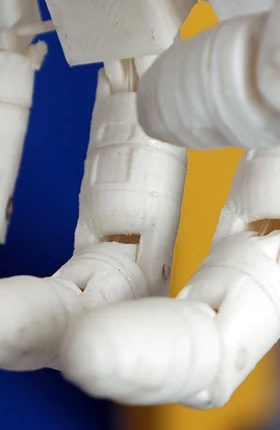Advanced technologies promise to have as much—or more—impact on engineering design and product development in the next 4 years as they have in the past 400. Engineering digital natives have shown what new ways of working rooted in digital technology can accomplish, and the results have been eye-popping for industry executives and investors alike. More traditional engineering powerhouses are making their own strides—and are sometimes leading the way—in such fields as the Internet of Things (IoT), artificial intelligence (AI), and machine learning.
Only 20 years ago, the advances of what was frequently referred to as Engineering 3.0—including 3D computer-aided design, simulation, and product data management—were on the cutting edge. Now, these innovations have been overtaken by the ability to integrate data gathered from across the enterprise (including from machines in the factory and machines in the field) with user-friendly tools to speed development cycle times, develop products more efficiently, and ensure higher quality and better product fit with customer needs and uses. Welcome to Engineering 4.0.
The race for the future is on, and it is already being run at a breakneck pace. Companies that want to stay in the lead, or jump to the front, need to focus on six areas. The first is their vision and roadmap—how they plan to move ahead. The next three are technical: data platforms, software architecture, and digital tools. Advanced capabilities and skills are yet another area that will be essential to realizing results. And new ways of working—specifically, an agile environment that enables cross-functional teams to iterate rapidly based on usage data and customer feedback—will be a primary differentiator for companies that want to sprint to the head of the pack.
The race for the future is on, and it is already being run at a breakneck pace.
Many companies are already active in one or more of these areas. Winners will set their sights on rapid progress in all six. Here’s how they can go about it.
The Transition to 4.0
Multiple factors are combining to create a fourth generation of engineering capability. One is yet another step change in computing power; technology continues to provide the ability to process more data and create ever more complex simulations. The IoT connects machines equipped with sensors and monitors to feed processors with more—and more detailed—data that can be used for data-driven design. AI automates design optimization and is especially helpful in developing designs for additive manufacturing (also called 3D printing) because its algorithmically driven processes are unconstrained by engineering conventions.
These types of advances aren’t just about machines that can do more. They are also enabling greater human collaboration and productivity. Cloud technologies allow for new ways of working together. Open access reduces or removes restrictions on the access to, and use of, innovations and designs by others, so it means faster and broader access to work from a variety of sources. And agile methods of working, which have moved beyond software development and R&D, use both new tools and advanced forms of teamwork as well as collaboration to increase speed and flexibility.
It’s a powerful combination. (See, for example, “Why Carmakers Are Racing to Go Digital,” BCG article, April 2018.) Our analysis indicates that companies that fully embrace proper execution of Engineering 4.0 can improve time to market by a factor of four and make material improvements in how their products fit customer needs. But it won’t happen overnight.
Six Building Blocks
Moving to Engineering 4.0 requires real effort to put the necessary building blocks in place. The benefits are achieved by empowering engineering teams with the right platforms, tools, and capabilities as well as broad access to data and agile ways of working. Most companies will need to build or augment their resources and abilities in each area. (See Exhibit 1.)
A Clear Vision and Roadmap. A well-defined plan helps companies prioritize and define the timing of digital initiatives and other proposals. The first step is agreeing on a portfolio of initiatives that is sufficiently robust to promote a step change in the operations and slim enough to ensure that the company maximizes its available resources. Next, companies need to develop a strong business case for each initiative and set feasible targets, priorities, and timelines. The timetables should aim both to capture synergies through cross-project resource utilization and to avoid waste with a clear view of dependencies between initiatives and of the critical path to completion.
Data Platforms. Product data availability and open data access for engineers are essential to boosting productivity. Best-practice companies apply product usage data to improving design and maintenance. They create automated feedback loops that deliver diagnostic and sensor data from the field so that it can be used for maintenance and to address design issues in the next product iteration. They also provide open data access for engineers, reducing the administrative burden and development delays that typically result from cumbersome and slow data requests. In our experience, three main points that companies need to address with respect to open access are the current difficulties in accessing information, the redundancy of effort caused by dual archiving or information storage, and the potential data security risks that arise from poor data management practices.
Software Architecture. Better data collection and open access typically require that companies redesign their software architecture. Leaders today follow a handful of common principles. They “write once, deploy anywhere”—enabling the flexible deployment of new features that use cloud, fog, and edge computing to optimize the interactions between field devices and back-end systems. They rely on cloud-based scalability of processing power and storage. And they pursue high productivity, parallel development, and the implementation of granular microservices such as coding, quality assurance, integration testing, and deployment.
Digital Tools. In addition to computer-aided design and engineering software, engineers today can employ such tools as digital mockups that simulate product functionality and performance and thereby obviate the need to produce physical models. These tools enable virtual teamwork, digital twins (the virtual representation of actual systems or modules of systems), and rapid prototyping of scale models using computer-aided design and 3D-printing technology. Engineers can pursue fast prototyping, testing, and problem-resolving processes that allow them to identify and fix design issues before the physical production phase. In addition, digital tools create new methods of virtual collaboration.
Advanced Capabilities and Skills. Digital tools and techniques require people with advanced capabilities and skills, such as data scientists and software architects, among others. In our experience, companies take one of two approaches to acquiring or building their capabilities, depending on their aspirations and the breadth of the gap between those aspirations and their current capabilities. The light-touch approach seeks to develop new skills within the company’s current structure by up-grading internal training and external recruiting as well as establishing partnerships with firms that provide digital services. The more aggressive approach involves a build-operate-transfer (BOT) center that accelerates the development of a critical mass of digital talent in-house and serves as a companywide transformation catalyst.
Agile Ways of Working. The final building block may be the most important—adopting an agile approach to product design and development. In the digital era, companies need to accelerate the implementation of initiatives, eliminate costly delays, and continually improve the customer experience. Agile, which relies on cross-functional teams and a fast iterative approach, has a proven track record in these areas. Organizations can reduce the complexity of internal operations and create powerful opportunities to shorten cycle times, design better products, and enhance customer relationships. (See “Taking Agile Way Beyond Software,” BCG article, July 2017.)
Barriers to Reaching 4.0
Taken on its own, each of these building blocks is a powerful force for improved productivity and better results. But in our experience, it is the combined impact of most or all that leads to a step change in effectiveness. And therein lies the rub: when companies try to tackle multiple dimensions simultaneously, they often run headlong into organizational resistance and current constraints.
Moreover, identifying and attracting employees who possess the newly required digital capabilities can be challenging for companies that have little or no track record in these fields. Not only are such experts hard to find, but talent attracts talent; companies that do not currently have a critical mass are doubly challenged because they must compete for needed skills with those that do, such as digital natives and other tech-focused organizations.
And, of course, companies face the hurdle of making the transition from traditional, often monolithic, product and IT architectures to digital technologies—while maintaining business continuity. They must balance the need to transform tech (as well as product development models and operations generally) with the equally critical need to manage their business during the transformation. Many are wary of costly multiyear technology transformation programs that generate value (or sometimes don’t) only at the very end of the process.
Companies must balance the need to transform tech with the equally critical need to maintain business continuity.
Getting Started
After working with numerous companies on the transformation of their engineering and design capabilities, we have developed a three-phase process that starts with a tight focus on the issues that a particular company faces, pilots solutions while the company builds the necessary capabilities, and then rolls out tested solutions across the organization. (See Exhibit 2.)
Phase One: Diagnosis and Pilot Identification. The first step for any company is to understand the impediments and pain points in its current engineering and design process through bottom-up diagnosis. This exercise also helps build digital awareness and raise the priority of digital transformation within the ranks of senior management.
Phase Two: Delivery of Short-Term Impact and Buildup of Capabilities. In phase two, the objectives are to show the kind of results that Engineering 4.0 can achieve through short-term, high-impact pilot projects while simultaneously highlighting the new capabilities that the company needs to build (such as agile ways of working) in order to make the transition to 4.0. Pilots also enable managers and engineers to experience working in agile teams. The pilot approach works best when the selected projects address big issues and relevant pain points for the organization.
Phase Three: Scale-Up of Engineering 4.0 Capabilities. In the third phase, the company uses the successes and lessons from the pilot programs to develop a vison, roadmap, and business case for a broader rollout that will shape the transformation of the engineering organization.
Big Changes, Big Results
Most companies need to make big changes in how they operate for Engineering 4.0, and such changes take time. But the results are worth the effort. One major automaker conducted a comprehensive diagnostic to identify the pain points and roadblocks in its design and engineering operations. The diagnostic led to a transformation program that involved a shift to digital systems and software as well as established new approaches and ways of working in multiple areas, including how the company uses data in design, how various functions collaborate, and how engineers employ virtualization tools and AI in new-product pilots and simulations. (See Exhibit 3.) The company rolled out 19 successful pilots and achieved a two to four times improvement in development cycle time. By using digital tools, the automaker was able to eliminate about 40% of the problems it encountered in physical design processes.
For companies that have seized the opportunity, Engineering 4.0 is fast becoming a competitive advantage. And because digital technologies advance at accelerating speeds, the leads that these companies open will only get wider. Given the complexity of the transition to 4.0 and the time that the journey takes, others will want to start their own journeys soon—while they still have the ability to catch up.









